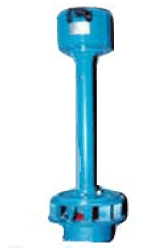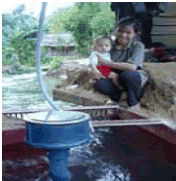Micro-hydro Resources
Home > RESOURCES > Web-based Resources > Energy Resources > Micro-hydro Resources
|
Readily available micro-hydro technologies which are used to charge batteries include Harris Hydro systems for higher head sites and Firefly systems for lower head sites.
1. Harris Hydro
The Harris hydro system is a battery-charging pelton turbine system suitable for a wide range of site conditions, from 6 meters of head to over 60 meters. Batteries are charged by the generator at low power round the clock and are able to produce large currents for short intervals to power a number of appliances simultaneously. A charge control regulator will make sure the batteries are not overcharged. The batteries can be used to power 12-volt appliances directly, as in the configuration shown at left, or they can be connected to a DC-AC inverter to operate conventional AC appliances.
System setup is based on the collection of water at an upstream location. The water is diverted to a small shelter where the turbine is installed. The turbine sits at the low end of a 2 to 6 inch diameter pipe. According to the manufacturer, the cost of Harris hydro turbines varies from US$1,000 to US$2,000, and the cost of battery storage capacity is about $150 per 100 W output. A DC system with output of 100 W is estimated at approximately US$1,500 (no inverter), while an AC system of 1,000 W output is estimated at US$7,800, including a $3,400 inverter. Additional details about the cost, power output, configuration and product features are available at: http://www.harrishydro.com. 2. Firefly Micro-hydro System The firefly system is a very small micro-hydro system that is primarily intended to provide lighting in isolated communities without grid connection. For storing electricity, 12 Volt ‘solar’ batteries can be used. Twelve-volt lamps and other appliances can be powered directly from the battery. With an inverter, ordinary 110/220 V appliances such as ICTs can be used as well.
The firefly charger is a secondhand car alternator with a `crossflow' runner mounted directly on the shaft. The Firefly charger is quite flexible with respect to head. The minimum flow and head it requires are 10 lps and 5 meters. At higher head, flow and output power can be reduced by inserting a blocking timber in the nozzle. Over the whole head range, the charger can operate at its optimum speed because field current of the alternator can be regulated. The firefly charge indicator shows how far the battery has been discharged by means of 10 LEDs.
Firefly building manual is available at: Index page for Firefly and other related sites The technologies most commonly used for AC micro-hydro systems are Peltric sets for high head applications and Power Pal systems for low head applications. 3. Peltric Sets
Peltric set technology is a term coined in Nepal to describe a small Pelton runner attached directly to an induction generator. Water is directed at the runner from one or more nozzles. This rotates the runner together with the induction generator attached to it, generating alternating current. The induction generator derives from the ubiquitous induction motor connected to capacitor banks to provide it excitation. An Induction Generator Controller (IGC) keeps the load on the generator constant by diverting unused power to ballast heaters. Peltric sets are used for relatively high head sites, above 30 m. The flow required to produce 1 kW of power at this head would be around 7 lps. The induction generator is very robust and virtually trouble free since it has no carbon brushes to wear out and there are no coils on the rotor. Source: http://www.icimod.org.np/sus_options/bestprac3.htm#peltric
PowerPal is manufactured in Vietnam under the supervision of a Canadian company, Asian Phoenix Resources Ltd. Low head PowerPal systems are available from 200 W to 1,000 W. According to the manufacturer, “A simple AC single-phase, brushless permanent magnet alternator is attached to a propeller turbine. All or part of the stream flow is diverted into an intake canal where it forms a vortex, causing the propeller to rotate as it exits through a draft tube to flow free again . All that is required is a vertical drop (head) and a sufficient rate of water flow, which are commonly obtained by installing PowerPal on a small waterfall, dam or diversion trench. Electricity passes along a wire and into a house, where an electronic load controller (supplied) stabilizes the voltage to 110 V or 220 V to protect electrical appliances during use. The ELC can also be used to set other voltages such as 120V, 230 V or 240V. Being lightweight and portable, installation is very simple and is explained in the Instruction Manual. Once installed there are no running costs and maintenance costs are extremely low.”
The 200 W PowerPal unit cost US$ 145 ex-factory price at Hanoi, Vietnam and the requisite intake canal and draft tube costs another US$ 55 but could be made locally to reduce the freight cost. High head PowerPal systems are now also available in the range of 200 W to 500 W. Other than the change of turbine, the High Head system is identical to the Low Head system.
1. Inversin, A.R. 1986. Micro-hydropower Sourcebook. NRECA International Foundation, Arlington, VA. Pp 285.
OTHER RESOURCES Small Scale Hydro - Fact Sheet by UNEP Microhydropower Portal |





